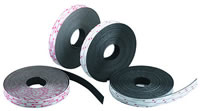3M Tape Technologies for Greater Application Success
Posted on Wed, Jun 13, 2012
Some materials are harder to bond than others. With 3M adhesive and tape technologies, even many materials once defined as "hard-tobond" such as low surface energy plastics, can be onded with strength greater than the materials bonded. The list of potential substrates ranges from glass, wood, cardboard, and rubber to steel concrete, foam, polycarbonate, and just about any other material you can name. 
Adhesives attach to the surfaces of the two substrates, unlike a process that fuses substrates into a unified whole such as welding metal or solvent activation of plastics. In selecting a 3M adhesive or tape, surface condition must be consdiered: roughness, smoothness, porosity, coated, uncoated, cleanliness, flexibility, size of part, and surface energy of the part.
Adhesive paste, for example, flows readily into a rough surface for improved effective adhesion. Flexible materials such as paper or thin gauge metal can be bonded with a thin adhesive transfer tape. Large rigid parts with smooth clean surfaces can be bonded with a variety of 3M products ranging from double coated foam tapes to two-part structural adhesives. Some plastics have plasticizer which migrate to the surface and degrade the bond over time, so a plasticizer-resistant adhesive or tape is essential. If the substrate has been powder coat painted, the coating is the bonding surface rather than the substrate, and you would want to consider a 3M tape or adhesive developed specifically for that surface.
Surface energy ranges from high to low. As a rule of thumb, the higher the surface energy, the greater the strength of adhesion.
For more information about 3M bonding adhesive products talk to a Gleicher representative!